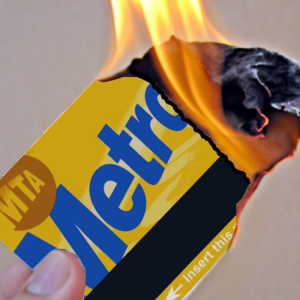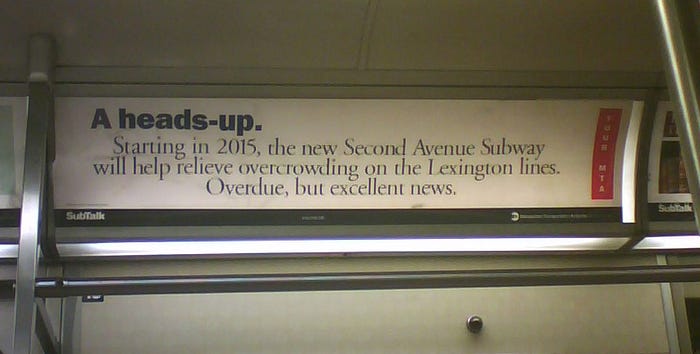Here Is What the MTA Will Do with Your Extra $4.50 a Month
Editor’s Note: This post originally appeared Mar. 22, 2015 on a now-defunct website (no, not Grantland). It has been republished here for archival.

If you’re a New Yorker like me, you probably already know that as of today (March 22nd), the MTA has ratcheted up the subway and bus fare once again, from $2.50 to $2.75 per ride or from $112 to $116.50 for a monthly pass. (Here’s the New York Times coverage of the increase, and here’s an update from the Authority themselves with a disingenuous headline that will make you want to fire a high-caliber weapon into an array of fifty-gallon aquariums until the rage subsides.) And unless you stepped off the bus from South Dakota yesterday, bright-eyed and full of hopes and dreams, you also know that this has become, like an unwise office romance, a distressingly regular occurrence. Back when I did my own bright-eyed, hopeful bus disembarking five years ago, we were at $2.25 /$89 monthly. That’s a ten-cent increase ($5.50 for a monthly pass) every year, and it’s only going to continue. But you know that.
What you probably don’t know is what the MTA plans to do with all that extra money, a figure I could not easily Google but which I will estimate, based on the number of people in my way when the door of the A train opens every morning, to be infinite beyond comprehension. After extensive digging into the MTA’s closely guarded budget plans, I’ve managed to piece together a list of planned improvements that will be partially or wholly funded by the upcoming bump in revenue. Now, I know as well as anyone to take New York City budget and timetable estimates with a generous block of salt, but I have to admit, a lot of these sound like promising developments.

MTA Budget: Fare Adjustment Revenue Allocations
Printing Costs
At least $1.8 million has been slotted for printing costs, the entirety of which will be used to produce a fleet of “Escalator Out of Service” signs for the brand-new, $1.4-billion Fulton Center. But hey, you’ll be able to read them using natural light, right? And the memory of that light shall warm you on your journey through the dank, subterranean stairwells.

Self-Promotion
Other funds will be put toward the MTA’s ongoing, concerted effort to educate the public about its many improvement projects, including signal and switch replacement, train car modernization, platform renovations, and capital programs like the 7 train and Long Island Railroad additions. A source within the MTA’s press office assured me that these projects were slated for completion “eventually to never,” stating, “While we do not actually plan to execute any such improvements, we remain very dedicated to promoting the illusion that they are happening.”
In-House Ad Development
This may come as a surprise, but the MTA does not actually earn any revenue from ad sales. All ad space on the subway system is deliberately and meticulously planned by an internal committee of senior employees, chosen by secret ballot and elected for life. The “Seven Great-Counts of the Many Posters,” as they are called, personally oversee the allocation of every divorce law pitch, professional degree banner, and Dr. Zizmor. A member of this elite group, who spoke on the condition of anonymity, confided to me that they’ve identified Seamless ads as an area of major growth potential. “The cheeky elitism of those ads targets a demographic with incredible expendable income, little self-awareness, and a knowledge of cultural references I would term ‘semi-post-current to grandparentian,’” she said. “It’s interesting in that they appeal to the sort of people who do not ride the subway, who do not even take cabs, who are only transported on the backs of servants or gilded pleasure barges. They will never see those ads. The subway riders, of course, despise the ads, but where else do you go to order Thai food online? It is a beautiful, soul-rending irony.”

Rat Removal
“It’s very difficult with the rats, catching them,” says the man known only as “Greasy Ed,” the MTA’s Director of Rodent Affairs. “We gotta starve the children for about a week, you know, before we send ’em into the system to get the rats. They won’t go after ’em if they’re not hungry. And of course there’s a tolerance issue; some of the real veterans, the kids who been at it since five or six, they need almost three weeks between hunts before they’re desperate enough.”
Rat King Removal
“The whole idea is to prevent the rat kings from forming in the first place,” Greasy Ed continued. “Once they become entangled and begin to move as one, that’s when the real problems start. We’ve found that nine is the magic number; nine or more rats get intertwined and it can really start to cause problems for the trains. I actually came up with a neat little way to remember this: [sings] ‘Eight little rats in a seething mass of matted fur, blood, and feces, you’re okay; nine little rats in a seething mass of matted fur, blood, and feces, you’re not okay.’”
Rat Food
“Rats gotta eat.”

KILL ME KILL ME KILL ME KILL ME (via mta.info)
Poetry in Motion
Nothing spruces up a dreary subway ride quite like the MTA’s Poetry in Motion program. Even on the worst commute imaginable, stuck between stations while one passenger vomits because another has pooped himself (yes I have actually witnessed this), you can look to these artful posters to bring balance, refreshing the mind and soul with this reminder: “No matter how bad life is, it could always get worse — you could actually finish reading this terrible fucking garbagepoem.” But the MTA’s Department of Abominations Against God and Man isn’t satisfied with the current state of Poetry in Motion, rating the current lineup of garbagepoems as “not nearly incontrovertibly bad enough,” according to Vice President of General Terribleness Sandora Plinth. “Whereas almost all modern poetry ranges from the blandly unacceptable to the viscerally offensive, our selections have averaged far too close to the tame end of that spectrum. We’ve even made the mistake of including an actually good poem, you know, the one from Seamus Heaney. We should have known better; his poems typically center on subjects of rich literary potential such as bogs or dirt, or the dirt found in bogs. It was an unforgivable blunder. You have my word: the next round of garbagepoems will be as stultifyingly awful as Hell itself.”
Scholarship Programs
The MTA’s Artist Outreach department is abuzz over a pilot program called Showtime Scholars, which sponsors on-the-job training for talented performers hoping to join the ranks of the subway system’s in-car entertainment specialists. A similar initiative begun in 2010 for station and platform buskers has shown encouraging results, and if the expansion to on-board performances is successful, the MTA hopes to start offering full-fledged classes for their entertainers. Potential course offerings include “Acoustics Matter: Choosing the Right Platform for Your Instrument,” “Hone Your Spiel: Public Speaking for Panhandlers,” and “The Best Tip Cup Is a Baby: Maximize Your Earnings Through Creative Collection.”
Ghost Removal
“You know that movie, Ghostbusters?” asks Phil Tremmelman of the MTA’s Supernatural Reponse Unit. “Most people don’t know, but that movie was based on my life! ‘Dogs and cats, living together’… I gave them that line.” When asked why additional funds were necessary, Mr. Tremmelman alluded to an unusual number of ghosts congregating at Classon Avenue on the G line. “The ‘G’ don’t stand for ‘good service,’ I’ll tell you that much!” he quipped.

Infrastructure Improvements
“Most riders don’t realize that the subway system is powered not by electricity, but by life force drawn from the souls of New Yorkers,” explained a Junior Engineer (who asked not to be named as he is not authorized to speak on behalf of the Guild of Wizards). “The best way to draw life force out of a soul is by trapping it in a labyrinth,” he continued, “so we’re always trying to create more labyrinths. The more labyrinths we can build, the more people we can herd into those labyrinths, and the longer we can keep their souls trapped in those labyrinths, the easier it is to harness their life force. You ever transferred at 168th Street? You’re actually powering the subway system. Yeah. Labyrinth. It’s all about creating more labyrinths.”
Never Running the L Train Ever Again
“Unless we devote every conceivable resource to this effort,” said one source within the MTA, “then there may come a moment in time when the L train is working, and if that should happen, what can we say but that we have failed?”

The Second Avenue Subway
I spoke briefly about one of the great pipe dreams in urban planning history with Project Overseer Claybourne Pambertam, who insisted that “progress on the East Side has never been better.” When asked about the ever-lengthening timetable and ever-increasing cost, he was happy to explain in detail. “What needs to be done is that every night, we fill up a truck with money, drive it to a big hole in the ground at 77th and 2nd, and dump it in. There’s a lot of overhead there that needs to be covered, labor and transport costs, things like that, and of course the actual money that gets dumped.” I asked Mr. Pambertam what he thought the fare for a single ride would be when the Second Avenue line finally opens to the public. His response? “Opens, hahaha! Hahahahahahaha!”
Good luck, fellow New Yorkers, because the fare hikes aren’t going anywhere. I guess we’ll just have to cut back on the Seamless.

